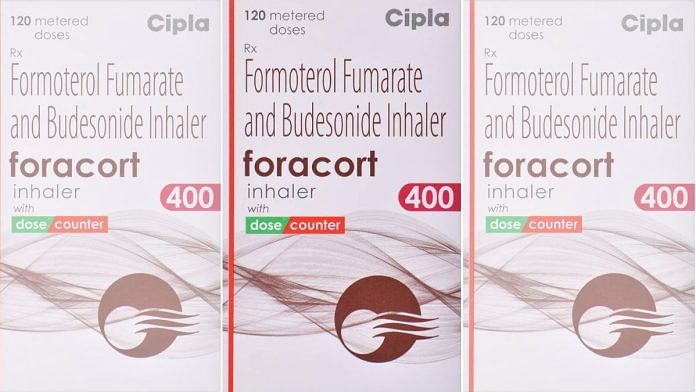


New Delhi: As air pollution in most parts of northern India reaches extremely severe levels, choking residents and engulfing cities and towns in toxic smog, respiratory drug Foracort has become the best-selling medicine in India, toppling strong contenders such as antibiotics and antidiabetics.
Monthly pharma sales data for October released by market research firm IQVIA this week showed that the drug—which is sold in inhaler form—clocked sales worth Rs 75 crore, higher than brands such as Augmentin, a broad spectrum antibiotic, and Glycomet-GP, an antidiabetic. ThePrint has a copy of the monthly pharma sale report.
Two other respiratory drugs—Duolin and Budecort—also entered the chart of top 20 medicine brands, registering sales worth Rs 48 crore and Rs 43 crore respectively last month.
In October, the Air Quality Index (AQI) in most north Indian cities—including the National Capital Region (NCR)—had not yet reached severe or hazardous levels. Delhi, ranked first among the most polluted cities globally this month according to Swiss group IQAir, had registered the highest AQI of 364 in October.
In November, the AQI in Delhi and adjoining areas, according to some weather monitoring groups, hit even the 1,000 mark. However, the AQI measurement system by the government limits it at 500.
In India, AQI is rated ‘poor’ at more than 200, ‘very poor’ at more than 300, and ‘severe’ or hazardous at more than 400. The recommended limit of AQI is 0 to 100.
Scientific evidence shows that living constantly in areas with high levels of air pollution considerably raises the risk of damage to the immune, neurological, reproductive, and respiratory systems, cancers, and heart attacks in the long term.
Exposure to highly polluted air—even short-term—can exacerbate irritation of the eyes, nose, and throat, coughing, wheezing, chest tightness, and breathing difficulties.
A total of 16 lakh deaths in India in 2021 were due to air pollution, with the use of fossil fuels, such as coal and liquid gas, contributing to 38 percent of these fatalities, the 2024 report of The Lancet Countdown on Health and Climate Change released last month had said.
Another study by The Lancet that came out in July this year showed that 7.2 percent of all daily deaths were attributed to PM 2.5 concentrations higher than the World Health Organisation (WHO) guidelines.
In this paper, scientists looked at 3.6 million deaths between 2008 and 2019 across 10 Indian cities, and overlapped them with a detailed map of the distribution of PM 2.5, a compound of cancer-causing pollutants so small they can penetrate the bloodstream.
Also Read: 5 pollution warriors who are fighting to save Delhi’s lungs
Mumbai-based pharma major Cipla’s Foracort is a medicine used to treat asthma and chronic obstructive pulmonary disease or COPD, a lung disease that makes it hard to breathe and can get worse over time.
The drug contains a combination of two drugs, dudesonide—a corticosteroid that reduces inflammation and swelling in the airways, and formoterol fumarate—a bronchodilator that relaxes and widens the muscles in the airways.
Pharma analysts pointed out that over the last couple of years, Foracort reached the top spot among the highest selling drugs in India between the months of November and January, mainly driven by pollution conditions, but this year, this trend has set in a month earlier.
“Going by the sales figure of the drug for the month of October, it is likely that it will rise further in November which typically sees the maximum number of severe category AQI days,” a Mumbai-based pharma analyst told ThePrint.
Clinicians underline that Foracort has shown excellent efficacy in treating chronic respiratory diseases such as asthma and COPD for many years.
“An increasing number of patients with acute and chronic respiratory issues due to rising pollution levels are driving the demand for such treatment therapeutics,” said Dr Pradeep Bajad, senior consultant, pulmonology and respiratory medicine, Amrita Hospital, Faridabad.
The drug is mainly indicated for asthma, COPD and chronic bronchitis patients and works well to improve airway clearance, reduce inflammation, provide symptom relief and improve quality of life for patients.
Bajad also pointed out that lung health awareness has evolved since the Covid-19 pandemic and increasingly, patients are asking to see doctors, asking for formal lung function tests.
“Additionally, increased awareness around respiratory health and preventive healthcare utilisation post the pandemic has resulted in higher demand for flu and pneumococcal vaccination,” the pulmonologist added.
Dr Vikas Mittal, a pulmonologist at Delhi’s CK Birla Hospital, too said that increased awareness about respiratory health, better diagnostic rates, and early intervention have led to more patients seeking long-term management solutions. “The Covid pandemic highlighted the importance of controlling pre-existing lung conditions to prevent complications.”
According to specialists, inhalers like Foracort offering dual-action therapy, have gained wider acceptance due to their proven efficacy in managing symptoms and reducing hospitalisation risks.
(Edited by Gitanjali Das)
Also Read: Delhi NCR RWAs are the new pollution crusaders. If only govt would give them timely answers



